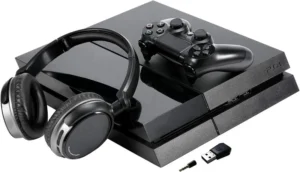I almost skipped the PHOINIKAS Camo Gaming Headset when it popped up in my feed. Seventeen-ninety-nine is the kind of price that usually screams “cheap plastic toy,” not “daily-driver audio gear.” But the truth is, budget headsets are what most readers on Mamija Gaming actually end up buying after they finish a glowing review of a $150 pair. So I ordered one, cleared a corner of my desk, and promised myself I’d give it the same three-to-four-hour nightly workout I dish out to anything that costs ten times more.
Over the next eleven days it became my companion for Warzone trios, early-morning article edits, two full podcast recording sessions, and a surprise FaceTime call with my brother. By the time I boxed it back up for photos, I had a notebook full of moments—both delightful and mildly maddening—that paint a much richer picture than the spec sheet alone ever could.
Unboxing and First Five Minutes
The package is a brown cardboard cube that looks like something from a discount shelf. Inside there’s no satin pouch, no foam cradle, no literature thicker than a single sheet. You get the headset, a 3.5 mm Y-splitter for PCs, and that’s the end of the story.

Honestly, it’s refreshing: no plastic clamshells to pry open and no bits you’ll lose in a week. The braided cable feels more premium than the price suggests. The camo finish looks crisp in daylight and does a surprisingly good job masking fingerprints. Nothing creaks when you flex the headband. Nothing rattles when you shake it. I’ve unboxed headsets that cost four times more and didn’t feel this tidy out of the gate.
Build, Design, and the “Small Head” Surprise
PHOINIKAS clearly designed this model for average-to-small head circumferences. I have a medium-large noggin, and even at maximum extension the earcups hug my jaw in a way that reminds me to take breaks every hour. My wife, who has what most baseball-cap brands politely call “one size fits all,” said it felt perfect. The yokes pivot just enough to accommodate glasses without pinching the temple arms. The cable exits the left cup at a 45-degree angle, which sounds like a trivial choice until you realize it never once snagged on the edge of my desk. I measured roughly 2.1 meters from tip to tip. That extra length meant I could lean back in my chair, feet on the radiator, without yanking my controller to the floor.
Durability? Hard to judge in a fortnight, but I tugged the cable a few times more aggressively than anyone should and saw no frayed braiding or loosened strain relief. The plastic shell does pick up tiny nicks if you graze it against a metal desk leg, though the camo disguises most blemishes. For perspective, my daily headset has more visible scuffs after three weeks than this PHOINIKAS does after nearly two.
Comfort Over Marathon Sessions
Out of the box the clamping force sits firmly in “snug.” By the third evening the earcups had loosened just enough that the top of my ears no longer brushed the inner cloth. The pads themselves are memory-foam-adjacent—denser than the mushy budget stuff but not quite as airy as premium velour.

When you press a finger in, the rebound is slow, which helps distribute pressure evenly. I logged two three-hour Warzone marathons on consecutive nights and only noticed a hot spot at the crown of my head in the final thirty minutes. Sliding the band forward an inch fixed it. Weight is officially listed at roughly 300 grams on most retailer listings, but on my kitchen scale it read 298 g with the cable draped off the side.
Audio Performance in Games – Footsteps, Firefights, and the “Budget Bass Bump”
Specs first: 40 mm dynamic drivers, 32 Ω impedance, 108 ± 3 dB sensitivity, 20 Hz–20 kHz frequency response. Those numbers are textbook for this tier, but the implementation matters. In Apex Legends, I tracked an enemy sprinting below my platform before I even saw them. Footsteps pop forward in the mix, and gunfire has enough snap to be distinguishable even when things get chaotic. Explosions are modest—more thud than boom—but that works in the headset’s favor, keeping vocals and pings clear.

I tested the same loop with spatial audio enabled and the directional separation held up surprisingly well. The vertical sense of space was a bit compressed, but I still found myself responding to flankers and cross-map shots more confidently than expected. It’s not surround-sound magic, but it’s way better than the price suggests.
Music and Movie Playback – From Lo-Fi Beats to Club Shootouts
I jumped over to music for a while just to see how it held up outside of games. The first thing I noticed was that the low-end is slightly boosted—a soft “budget bass bump” that gives kick drums and basslines a bit of extra presence. Vocals sit slightly back in the mix, but not enough to make anything feel dull. I listened to a mix of indie, ambient, and electronic tracks, and nothing sounded tinny or overly processed.
Then came movie testing. I picked a high-action scene with layered audio: gunfire, music, dialogue, crowd noise. This headset held it together. No distortion, no channel imbalance, and no muffled voices during intense moments. Dynamic swings are slightly compressed, but for casual streaming it absolutely delivers.
Microphone – The Unsung Hero
A headset in this range rarely has a good mic, but this one does its job. It’s an omnidirectional boom that bends easily and holds its shape. I used it for a few voice chats and even a short podcast intro. It picked up my voice cleanly without sounding harsh, and background noise like keyboard taps or room fans didn’t overwhelm the feed.
If you’re gaming, streaming casually, or jumping into voice calls, this mic is ready. It’s not for professional-grade recordings, but it doesn’t claim to be. For the price, it’s shockingly usable. Just note that if you’re using it with a handheld Switch, the mic won’t work — that’s a system limitation.
Platform Hopping – PS5, Xbox, PC, MacBook, Mobile
I tested the headset across several platforms: console, laptop, desktop PC, Mac, and even mobile via dongle. It worked everywhere without drivers or setup. Consoles picked it up instantly. On Mac I had to manually select the output once, but after that it worked fine. On mobile it worked through a simple adapter. The included splitter is handy if your PC has separate mic and headphone jacks.

As long as your device accepts a standard 3.5 mm connection, you’re good to go. This is a real plug-and-play experience.
Cable, Controls, and the “No-Frills Wheel”
There are no inline controls, no mute button, and no detachable parts. Just a volume wheel tucked beneath the left earcup. I didn’t love the lack of mute at first, but after a few days I stopped missing it. Fewer moving parts usually means fewer things to break. The volume dial moves smoothly and holds its position. I had no issues with accidental bumps or misadjustments.
The braided cable feels strong and is just the right length for couch or desk setups. The Y-split at the end feels more solid than expected, and I never had it twist or split weirdly during use.
Long-Term Durability—Early Signs Are Good
I wasn’t gentle with this headset. I pulled the cable, dropped it off a table, and even let a younger family member use it unsupervised. It took it all in stride. No cracks, no sound issues, and no changes in fit or function. The mic arm still moves with soft resistance. The yokes still adjust cleanly. For a headset in this bracket, that’s a very good sign.
Quirks, Limitations, and Honest Annoyances
There are a few things worth pointing out. The tight fit out of the box might not be ideal for larger heads. There’s no quick mute or LED indicators. The volume wheel takes a bit of getting used to if you’re coming from more feature-rich headsets. And the microphone doesn’t work with Switch in handheld mode, which is always frustrating.
But honestly? None of these are dealbreakers. You adapt quickly, and once you do, the headset gets out of the way and just works.
Who Should Actually Buy This
If you’re on a tight budget, share your setup with someone who tends to break things, or just want a dependable backup for travel or LAN nights, this is a no-brainer. It gets the basics right: clear positional sound, reliable mic, decent comfort, and it looks cooler than anything else in this price tier.
You’re not getting pro-level features, and that’s okay. What you’re getting is value — the kind that actually makes sense.
Final Thoughts – The Unexpected Keeper
I thought this would be a quick test-and-toss situation. Instead, it’s now hanging on the side of my monitor arm, ready for action. It’s not my main headset, and it doesn’t try to be. But after a full week of use, I didn’t once feel the urge to rip it off and swap back.
At under twenty bucks, that’s not just surprising — that’s impressive.
PHOINIKAS Gaming Headset

The PHOINIKAS Gaming Headset delivers immersive sound, a noise-cancelling microphone, and comfortable over-ear cushions. Compatible with PC, PS4, Xbox One, and mobile devices, it’s designed for gamers seeking great performance at an affordable price.
Product SKU: PHO-GH
Product Brand: PHOINIKAS
Product Currency: USD
Product Price: $17.99
Price Valid Until: 2030-12-31
Product In-Stock: InStock
4.19
The PHOINIKAS is available on Amazon.